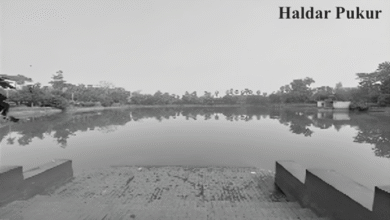Book Review: Floors tell a thousand stories
New book on Kashmiri carpets focuses on the history of floorings, the local craftsmanship & challenges

BOOK REVIEW
 “I caught a glimpse of the intricately designed Kashmiri carpet in the light of the lantern inside the mosque. The base colour of the carpet was red. It was thick and comfortable.” (Translated from Bengali) In his book Alik Manush (The Illusory Man), Syed Mustafa Siraj describes the interior décor of a mosque as a prelude to a solemn discussion between a father and his two sons. The Kashmiri carpet sets the mood for the conversation that follows and puts the persons concerned at ease.
“I caught a glimpse of the intricately designed Kashmiri carpet in the light of the lantern inside the mosque. The base colour of the carpet was red. It was thick and comfortable.” (Translated from Bengali) In his book Alik Manush (The Illusory Man), Syed Mustafa Siraj describes the interior décor of a mosque as a prelude to a solemn discussion between a father and his two sons. The Kashmiri carpet sets the mood for the conversation that follows and puts the persons concerned at ease.
Kashmiri carpets have always caught the imagination of all for the intricate designs, the vibrant colours and the comfort. They are intrinsically associated with history, tradition, emotions, and often with stories told and untold. It is these untold and unknown stories that designer, researcher and academic Promil Pande weaves together to present her latest book, Floor Coverings from Kashmir.
While intricately designed Kashmiri carpets have always been associated with affluence and royalty, not many are aware of the hard work of the artisans in making one such wonder. Pande not only writes about the process of making the carpets but also the history of carpets in India.
Carpets are put on the high pedestal of Indian textile art and Kashmir is one of the places where this art has flourished for centuries. Artisans from this region have their own style and nuances in weaving carpets.
The mention of Kashmiri carpets can be traced back to Nilamata Purana of the 6th or 7th century CE. Though the origin of carpets is debatable, “the contiguous regions of Persia (Iran), Turkmenistan, Central Asia, Mongolia and China are referred to as the carpet belt”.
 “At the same time, India, Iran, China, Pakistan, Nepal and Turkey are considered important carpet producing regions of the world,” writes Pande. Kashmiri carpets were among the popular trading items and formed a major source of domestic income in ancient and medieval India.
“At the same time, India, Iran, China, Pakistan, Nepal and Turkey are considered important carpet producing regions of the world,” writes Pande. Kashmiri carpets were among the popular trading items and formed a major source of domestic income in ancient and medieval India.
Persia, owing to its geographical location, had the opportunity to experiment with weaving materials and improvise on designs and methods of carpet making. It earned the best position in carpet weaving in the world for centuries. With time, India came to the forefront as a competitor.
“The prevalence of exquisite workmanship in the region resulted in the importance and global popularity of Indian textile crafts that enabled royal looms in India on occasion to compete with Persia in production of unsurpassable carpets. The Mughal Emperor Akbar (1556-1605) thus was prompted to not only acquire the theoretical and practical knowledge of the whole trade, but to additionally bestow special care and imperial patronage to the intelligent ‘workmen’,” writes Pande.
It is believed that Sultan Zain-ul-Abidin brought craftsmen from Persia to Kashmir who trained the local artisans in intricate carpet weaving. Though ‘Kashmiri carpet’ is used as a general term, there are many varieties of these floorings. The carpets produced in this region are called kaleen, “which are hand-knotted and produced mostly by home-based workers”. The Kashmiri floor coverings also consist of namda, gabba, wagoo and ari rugs. Besides the weavers, several other communities — such as colour coder, designer, ironsmith, yarn supplier and washerman — contribute to the making of each variety of carpet.
The embroideries and the method of weaving are also unique in each variety. In fact, embroidery “is one of the largest sectors of cottage crafts in the state”.
In her coffee table book, Pande not only writes about the economic and cultural importance of the carpets but vividly describes each variety. Her in-depth research and lucid descriptions are complemented by beautiful photographs of the region and the carpets that it produces. The book also gives an insight into the lives of the craftsmen and their challenges in the current political and economic upheavals. Floor Coverings from Kashmir is not only a must-have for art aficionados and students of design and textile engineering but also an interesting read for laymen as this helps in spreading awareness on one of the most coveted handicrafts of India.
Book: Floor Coverings from Kashmir: Kaleen Carpets, Namdah, Gabba, Ari Rugs and Wagoo Mats; Author: Promil Pande; Publisher: Niyogi Books; Pages: 235; Price: Rs 2500
— Team Sunday Shillong





